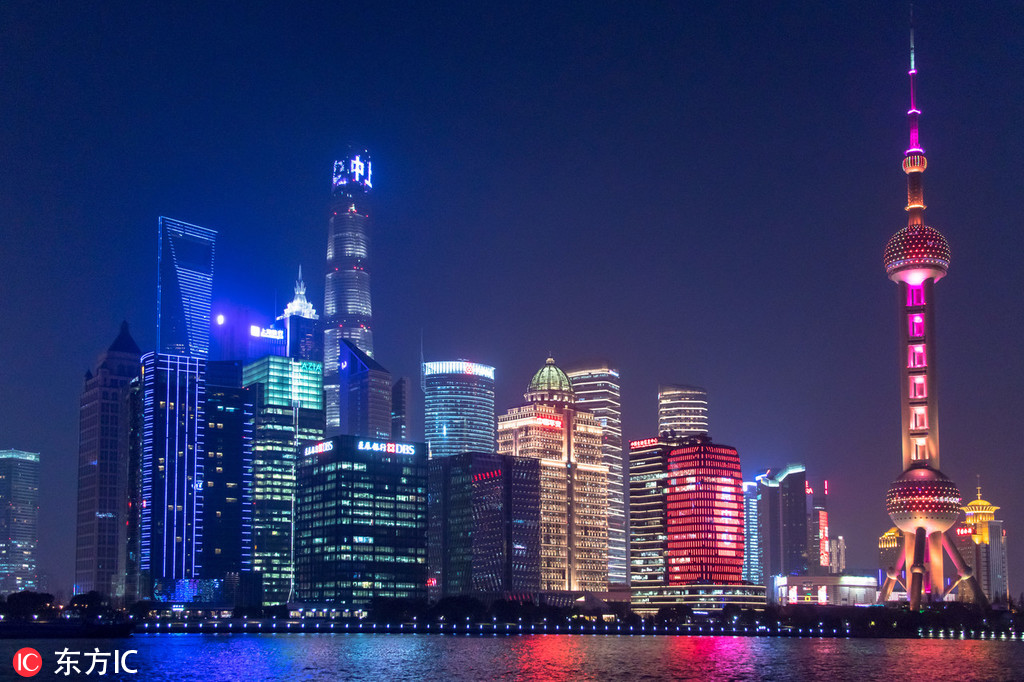North Bund offers city cruise for travelers

The Shanghai North Bund's storied history has entered a new chapter with the development of a 'cruise city' for leisure travelers, Yang Feiyue reports.
A historical port has become a modern attraction in Shanghai. Some older residents still call the Beiwaitan, or Shanghai North Bund, by its old name, Gaoyanglu wharf.
The North Bund hosted some of China's earliest wharfs, starting from the 1800s. Political figures, such as former premier Zhou Enlai, and overseas students departed from here to such foreign lands as Japan and Europe.

The Shanghai North Bund provides a panoramic view of the city featuring some of its landmark buildings. [Photo/IC]
The North Bund's wharfs along the Huangpu River, an estuary of the Yangtze, have remained important to Shanghai's shipping industry, especially exports, over the past 170 years.
Briton Hamilton Lindsay is an integral character in the North Bund's story, says historian Xue Liyong, who researches Shanghai's past.
"The British didn't know much about Shanghai before his arrival," Xue tells China Tourism News.
Lindsay realized the Shanghai port's strategic importance when he visited there in 1832.
Its location in the center of China's coastline made it ideal for cargo transport between the north and the south.
The sea north of the Yangtze's mouth is shallow because of silt deposited by the river, while the waters to the south are deeper and dotted with islands.
Consequently, ships coming from southern coastal provinces like Fujian and Guangdong had to transfer their cargo to ships suitable for the waters to the north and vice versa, Xue explains.
Lindsay's report on his findings contributed to Shanghai's inclusion in the Treaty of Nanking that the British forced China to sign in 1842.
This opened the city to merchants from Britain and, later, other Western nations, such as France, Germany and the United States.
The British East India Company established China's first foreign-funded wharf, Hongkou (then known as Hongkew) in 1845. It grew to become the largest of its kind in 1853.
This kicked off a wave of port construction. Over a dozen foreign wharfs sprang up along the North Bund's shoreline.
Jardine Matheson acquired all of the North Bund's foreign wharfs in 1875 and built the Shanghai and Hongkew Wharf, from which tons of such Western products as textiles, machinery and glass entered China. Chinese tea and raw silk were, in turn, shipped to the West.
The nation's wharfs were nationalized after New China's founding in 1949.
The Shanghai and Hongkew Wharf was renamed Gaoyanglu in 1954. It then handled a third of the city's imports and exports, says Zhang Yaqing, a former senior official, who was in charge of its operations.
China's economic development increased the port's throughput.
But it failed to keep pace with the growing demand for international cruises.
Cargo shipping was shifted from the Huangpu River to the offshore Yangshan Deep-Water Port. The North Bund's vacated shoreline was rebuilt as the Shanghai Port International Cruise Terminal.
Costa Allegra became the first passenger cruise liner to depart from the terminal in 2006. The port received 512 liners and 2.98 million passenger visits over the following decade.
The North Bund today is a passenger, business and leisure hub.
The terminal hosts about 60 berths and is the only one on the Huangpu that can receive foreign yachts.
Shanghai International Port (Group) Co opened a "cruise city" on the site in September 2018.
The destination is a national 4A tourism site. (5A is the highest rank.)
The 73,000-square-meter attraction hosts a sightseeing lane and cultural gallery, where visitors can learn about the Huangpu River's history. It also features a music square, port museum and shops.
The cruise city recently installed a high-altitude rope-climbing course that offers spectacular views from above. It hosts 94 challenges of different difficulty levels for visitors ages 4 to 60. There's also a giant swing and bungee jumping.
"The cruise city is an important memory of old Shanghai," says Xu Juehui, a senior official with Shanghai Port International Cruise Terminal Development Co.
"It continues the legacy of the Huangpu River's shipping history."
Contact the writer at yangfeiyue@chinadaily.com.cn
MOST POPULAR
- 1 China to give visa-free treatment to another 9 countries
- 2 China fully opens manufacturing sector to foreign investors in landmark opening up move
- 3 China's import expo attracts record-breaking participating countries, exhibitors
- 4 China's door opening even wider to foreign visitors, businesses
- 5 China revises rules to ease foreign strategic investment in listed firms
Editors' Picks
 Video:
Peru sees new port open
Video:
Peru sees new port open
 Infographic:
China's public holidays for 2025
Infographic:
China's public holidays for 2025
 Infographic:
Basic facts of APEC
Infographic:
Basic facts of APEC
 Infographic:
Wrapping up the 7th CIIE: Data recap
Infographic:
Wrapping up the 7th CIIE: Data recap



